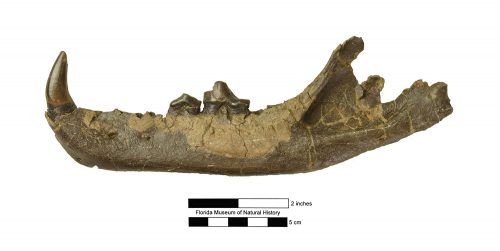
For this week’s Fossil Friday, we have a dentary (mandible) of an amphicyonid from the Cucaracha Formation of Panama. This specimen was found near the Centenario Bridge and is Early Miocene in age. Amphicyonids, commonly called bear dogs, were an Old World taxon that migrated from Europe to North America during the Miocene. They are members of the mammalian Order Carnivora along with modern dogs, bears, walruses and raccoons, to name just a few. One of the defining characteristics of carnivorans is their teeth, which include prominent canines and carnassials. The fourth upper molar and first lower molar are termed carnassials and are teeth that are designed to shear meat like scissors.
To find out more about an indeterminate amphicyonid from Panama, read this paper about Miocene mammals of Panama here.
References:
Feldhammer, G. A., Drickamer, L. C., Vessey, S. H., Merritt, J. F., and Krajewski, C. (2007). Mammalogy: Adaptation, Diversity, Ecology. 3rd ed. Baltimore: Johns Hopkins UP. 316. Accessed online at http://books.google.com on Feb. 16, 2015.
0 responses to “Fossil Friday 2/20/15: A bear dog”